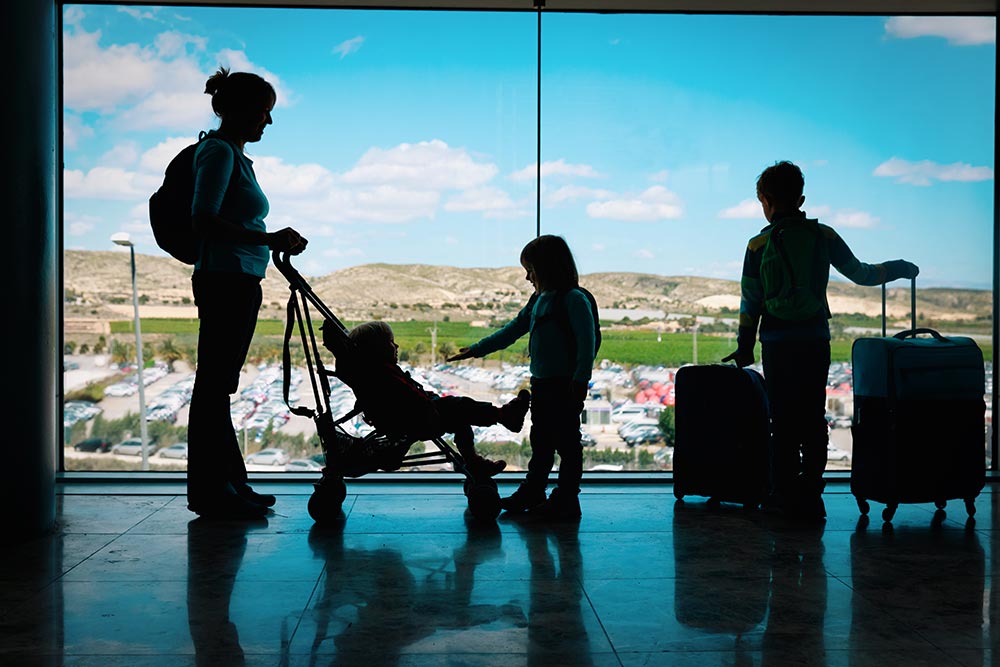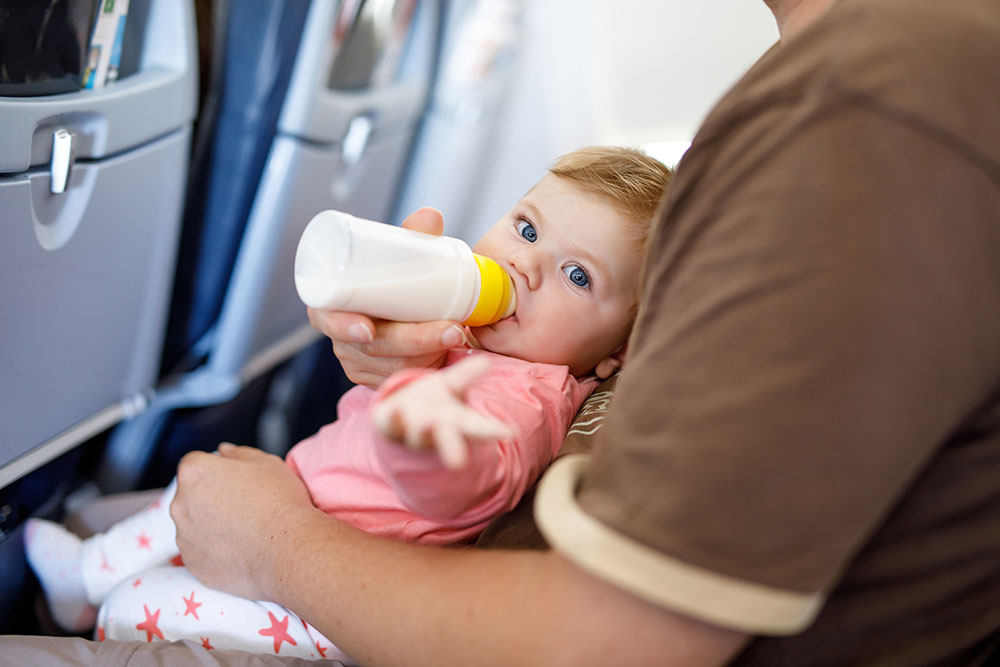Tips for Traveling With Baby

Adjust your expectations and plan for success by heeding our advice for junior jet-setters.
Expert Sources: Tracei D. Ball, MD; Carole Hallett Mobbs; Carol Wilkinson, MD, PhD
Traveling with a baby doesn’t exactly elicit imagery of relaxing family togetherness. But that doesn’t mean it’s impossible or that you should avoid doing it. Although the American Academy of Pediatrics (AAP) advises keeping your newborn at home to avoid illness and establish a routine, family travel is sometimes necessary (and desirable!). The good news is there are ways to make your adventure safer, easier, and more enjoyable for your growing family.
Pinpoint the “Right” Time to Fly
One of the main concerns when flying with an infant is the increased chance of exposure to germs. It’s easy—and common—to catch something on a plane, no matter if it’s a short or long flight, domestic or international. While for adults picking up common cold germs is typically nothing to worry about, little ones are especially vulnerable to any illness, including respiratory viruses, such as the flu, respiratory syncytial virus (RSV), and COVID.
Due to high airflow and air filter efficiency on airplanes, most viruses, including COVID, don’t spread easily on flights. However, time spent in security lines and airport terminals increases the duration of being in larger crowds, leaving travelers susceptible to catching germs from other people. The Centers for Disease Control and Prevention (CDC) recommends all eligible passengers get up to date on their COVID vaccines before traveling, as well as following continued recommendations to wear masks in indoor public transportation settings. And since children under 6 months aren’t yet eligible for the COVID vaccine, non-essential travel for families with young infants is not recommended. Travel by car if possible, but if you must travel by air, pack plenty of sanitizer and book direct flights to minimize transit time.
Regarding other potentially threatening diseases, Carol Wilkinson, MD, PhD, a pediatrician at Boston Children’s Hospital, advises parents to wait until their infant has had the first round of recommended vaccinations (generally at two months, although as early as six weeks) to travel by plane, train, or bus for the first time. But flying with an infant isn’t just your doctor’s decision. Many airlines, including Southwest, have an official policy that requires passengers to be at least 2 weeks old before boarding. There are always exceptions, however, and most airlines will accept a newborn with a medical release from a pediatrician.
So why two weeks before baby’s first flight? “This allows time for possible health conditions that were not found on the initial newborn exam to be discovered. Some conditions, such as heart or lung issues, may make it unsafe for your infant to fly, or these conditions may restrict when and how long your child can tolerate a flight,” says Tracei D. Ball, MD, chief medical officer of OnCall Mobile Medical and Wellness.
If possible, it’s smart to delay travel until the mother has had her postpartum checkup as well. “While traveling with a newborn may be comfortable for the baby, the mother may find it painful or unpleasant if she had a C-section. She may not be permitted to fly or travel until cleared by a doctor, usually at a six-week check,” reminds Carole Hallett Mobbs, founder and editor of ExpatChild.
Brainstorm Your Baby Gear Plan
Here’s a travel tip from veteran parents: Make the airport process as easy as possible by checking your bags curbside instead of lugging them inside to the general ticket desk. Lines are often shorter, and you can ditch unnecessary gear as soon as possible. What’s more, by skipping the indoor ticket desk, you’re not only saving extra time but also avoiding the crowds—and germs—lingering in line. Fortunately, most airlines—including Delta, American, and United—allow you to check baby-related items like car seats, strollers, and folding wagons for free. Some even allow travel cribs or bassinets at no charge.
If you’re keeping your stroller to cruise the airport, opt for a travel system that allows you to easily detach the car seat and remove baby when you check the stroller at the gate. Remember, you will need to take apart the entire system and send your gear through the scanner at security. Although a stroller is handy for hauling your tot and belongings, there are definite upsides to checking big gear and wearing baby in a carrier or wrap instead.
To date, security checkpoints allow you to walk through metal detectors with your little one in a baby carrier. (If they’re in a stroller or car seat, you will have to remove your child and walk through the detector while holding them in your arms.) And because children 12 and younger are not required to remove shoes at security check-in, you won’t have to worry about your kiddo’s footwear. However, TSA agents may ask to swab hands for residue or do a light pat-down.
If you decide to use an extra seat for your child as opposed to your lap, keep in mind that some travel car seats can pull double duty, serving as an FAA-approved child safety restraint system on the flight. There are also stroller/car seat hybrids that combine both products into one piece of amazing baby gear for ultra convenience and ease of use. Whatever you choose, be sure to check out whether your specific model may be used this way well in advance of your trip.
Be Prepared for Airport Security
Before heading for the airport, ensure you’ll have everything you need to feed your little one while in transit. If bottle-feeding, remember to pack plenty of formula (both powder and ready-to-drink liquid versions are allowed), sterile nipples, and other feeding supplies in your diaper bag. And for breastfeeding parents, consider bringing along nursing pads, a collection cup, backup breast shields, and a nursing cover (if desired).

According to the Transportation Security Administration (TSA), security should treat breast milk and liquid formula the same way they treat other medically necessary liquids in carry-ons. This means parents are allowed to bring more than 3.4 ounces of breast milk or liquid formula, but both can be inspected at the security checkpoint. The TSA website states that for a smoother, expedited screening process, it is recommended that liquid formula and breast milk be transported in clear, translucent bottles and not plastic bags or pouches, as these types of packaging can interfere with the scanning process. Additionally, you may be asked to open these containers to test for explosives or concealed prohibited items. If you do not want your breast milk or liquid formula X-rayed or opened, it’s advised to let your TSA agent know, so additional steps can be taken to clear the packed liquids.
For powdered formula, if the container exceeds 12 ounces, simply remove it from your carry-on bag and place it into a separate bin for X-ray screening. Powdered formula containers can either be opened or closed to go through security.
While there is no official rule for how much formula or baby food you can bring on a plane, TSA encourages families to only bring what baby needs. This can be tricky for new parents who may not know what their newborn will consume from one day to the next. To be safe, pack what you think you’ll need plus a bit extra in case your flight gets delayed or canceled.
Pro tip: Feeding your little one during air travel is a great tool for combatting cabin pressure that may irritate baby’s ears during takeoff and when descending before landing.
Choose a Family-Friendly Cruise Line
Cruises can be a potentially relaxing way to travel with a baby. Once the airport or road trip to the port is behind them, families can move at their own pace and enjoy their vacation from the moment they step on deck. Keep in mind that while the CDC recommends all cruise passengers be fully vaccinated and boosted (if applicable) against COVID, different cruise lines have different requirements for vaccination and pre-boarding testing for adults and children.
It’s worth noting that not all cruises are baby-friendly or equipped with common conveniences. In fact, many cruise liners don’t allow babies until they’re at least 6 months or older, including Disney. However, Disney does sell baby supplies on their ships, such as diapers, wipes, ready-to-feed formula, pacifiers, and much more to make packing easier. You can also request a portable crib and diaper pail for your Disney cabin, though these items are subject to availability. And speaking of diapers, if you have older babies who are ready to swim, always check your chosen cruise ship’s policy on swim diapers before you book, as many do not allow swim diapers in the pool or splash areas.
While most baby-friendly cruises offer strollers and highchairs, some need to be reserved in advance or are distributed on a first-come, first-served basis. Have a backup plan in mind in case a stroller isn’t available or you need more diapers than anticipated. Remember many cruise cabins come equipped with only a shower and a small sink. Unless you want to bathe your baby while holding them in the shower, request a cabin that has a tub, or pack an ultra-portable model.
Lastly, unlike other modes of transportation, cruises are difficult to navigate with an endless sea of baby gear. Excess gear needs to be stored somewhere in the confines of your cabin. It may be necessary to splurge on a bigger space, so you can spread out and walk around with a restless newbie in the middle of the night.
Find a Peaceful Home Away From Home
Young infants don’t need much to settle in for the night short of a place to sleep and sustenance. But hotel walls aren’t very soundproof and you may be dealing with jet lag and a disrupted naptime schedule. You risk waking up your neighbors in the middle of the night with a crying baby—or worse, having loud guests next door disrupt your baby’s sleep.
To avoid trouble, ask the attendant for a quiet hotel room, and explain you’re worried your baby will wake up surrounding guests. They’re more likely to respond to the pervasive threat of multiple complaints than give you a quiet room for the sake of your little one’s sleep.
If possible, opting for a private rental home will lessen the stress of a baby overnight. Having necessities like a fridge, store, and microwave for cooking and storing formula or pumped breast milk will be a huge convenience. Inquire about the use of a bathtub instead of a solo shower, as well as stairs, fireplaces, or anything else that can present a potential problem. Many baby-friendly rentals come stocked with babyproofing supplies and other gear for families with small children, such as baby gates, a playpen, a highchair, toddler tableware, and more.
Similarly, you may be traveling to stay with family members or friends for the holidays, and while you’ll likely find some of the same comforts as you have at home like a kitchen and your own bedroom, keep in mind that people who don’t have little ones likely won’t be prepared for a baby in their home. Just as you would inquire about amenities with a private rental, have a conversation before your visit about what’s available and what needs to be brought with you on your trip. Lastly, if you’re visiting loved ones with a pet(s), make sure you’re given clear instructions on how to interact with the animal to keep everyone harmonious and safe while together under one roof.
Take the time to do a little research before your trip. A bit of forethought and a hefty dose of flexibility can make for an agreeable adventure the entire family enjoys.







